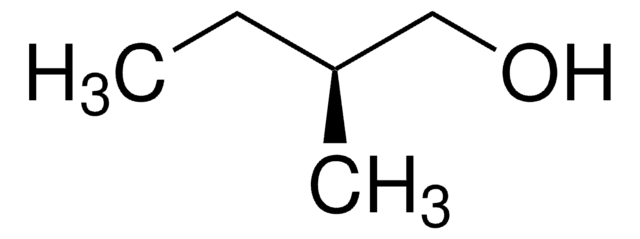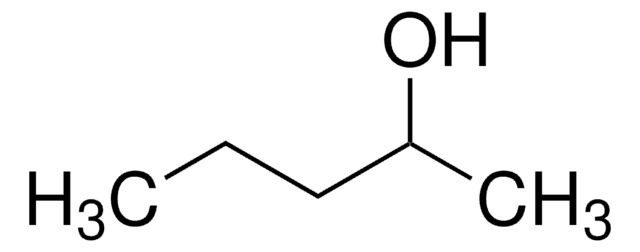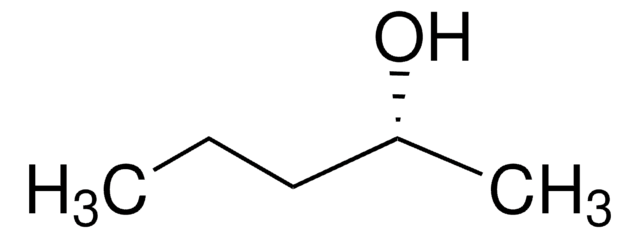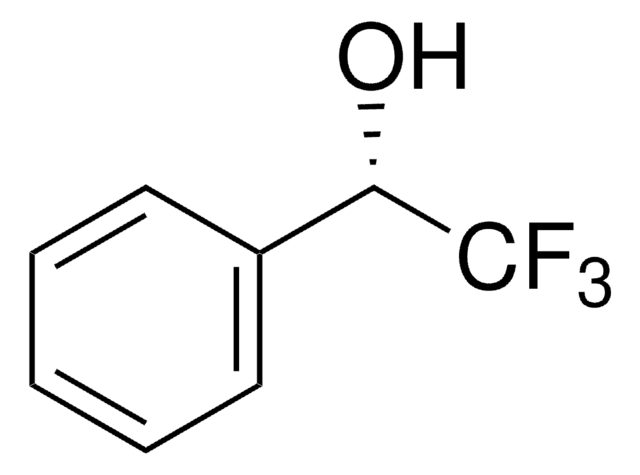Kluczowe dokumenty
236691
(R)-(−)-2-Butanol
99%
Synonim(y):
(R)-(−)-sec-Butyl alcohol
About This Item
Polecane produkty
gęstość pary
2.6 (vs air)
ciśnienie pary
12.5 mmHg ( 20 °C)
Próba
99%
Formularz
liquid
aktywność optyczna
[α]20/D −13°, neat
temp. samozapłonu
761 °F
granice wybuchowości
9.8 %
współczynnik refrakcji
n20/D 1.397 (lit.)
bp
97-100 °C (lit.)
gęstość
0.807 g/mL at 20 °C (lit.)
grupa funkcyjna
hydroxyl
ciąg SMILES
CC[C@@H](C)O
InChI
1S/C4H10O/c1-3-4(2)5/h4-5H,3H2,1-2H3/t4-/m1/s1
Klucz InChI
BTANRVKWQNVYAZ-SCSAIBSYSA-N
Szukasz podobnych produktów? Odwiedź Przewodnik dotyczący porównywania produktów
Zastosowanie
- 1-[(S)-2-butyl]-3,5 diphenyl-1H-1,2,4 triazole from 3,5 diphenyl-1H-1,2,4 triazole by Mitsunobu reaction.
- 2-butyl tosylate building block by reacting with toluenesulfonyl chloride.
Zastosowanie
Hasło ostrzegawcze
Danger
Zwroty wskazujące rodzaj zagrożenia
Zwroty wskazujące środki ostrożności
Klasyfikacja zagrożeń
Eye Irrit. 2 - Flam. Liq. 2 - STOT SE 3
Organy docelowe
Central nervous system, Respiratory system
Kod klasy składowania
3 - Flammable liquids
Klasa zagrożenia wodnego (WGK)
WGK 3
Temperatura zapłonu (°F)
71.6 °F - closed cup
Temperatura zapłonu (°C)
22 °C - closed cup
Środki ochrony indywidualnej
Eyeshields, Faceshields, Gloves, type ABEK (EN14387) respirator filter
Wybierz jedną z najnowszych wersji:
Masz już ten produkt?
Dokumenty związane z niedawno zakupionymi produktami zostały zamieszczone w Bibliotece dokumentów.
Klienci oglądali również te produkty
Chromatograms
suitable for GCsuitable for GCsuitable for GCGlobal Trade Item Number
| SKU | GTIN |
|---|---|
| 236691-10G | 4061838785787 |
| 236691-1G | 4061838785794 |
Nasz zespół naukowców ma doświadczenie we wszystkich obszarach badań, w tym w naukach przyrodniczych, materiałoznawstwie, syntezie chemicznej, chromatografii, analityce i wielu innych dziedzinach.
Skontaktuj się z zespołem ds. pomocy technicznej







